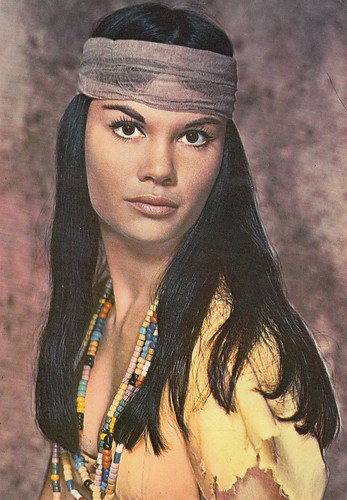
Spanish postcard by Oscarcolor, no. 377. Wende Wagner as Native American character Sally in Rio Conchos (Gordon Douglas, 1964).
Playing Native Americans onscreen
These actresses played Native Americans in movies. Some of them even did it several times.

British postcard, no. 71. Photo: American Biograph. Mary Pickford in Iola's Promise (D.W. Griffith, 1912).
At the beginning of her career, Mary Pickford played several times Native Americans under D.W. Griffith’s direction. It seems that the great director liked to cast her in this kind of role because her hazel eyes were filmed dark. This postcard probably refers to Iola’s Promise (D.W. Griffith, 1912).
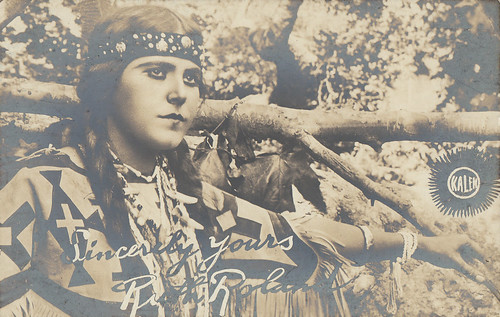
British postcard, no. 70. Photo: Kalem.
During her stay at Kalem, Ruth Roland was given several times Native American roles. This postcard possibly refers to The Indian Maid’s Warning (Pat Hartigan, 1913).
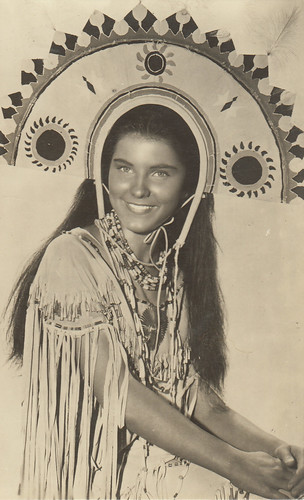
Spanish postcard no. 1212. Debra Paget as Native American character Sonseeahray in Broken Arrow (Delmer Daves, 1950).
Debra Paget also played Native Americans in White Feather (Robert D. Webb, 1955) and The Last Hunt (Richard Brooks, 1956).
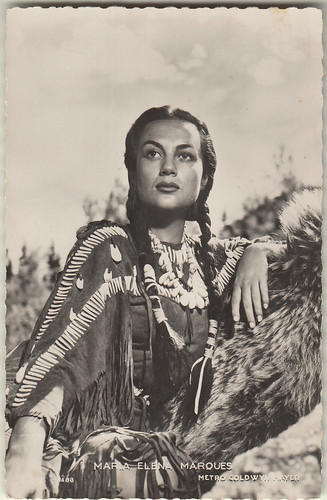
French postcard by Editions P.I., Paris, no. 488. Photo: Metro-Goldwyn-Mayer. Maria Elena Marques as Native American character Kamiah in Across the Wide Missouri (William A. Wellman, 1951).
Maria Elena Marques also played a Native American in Ambush at Tomahawk Gap (Fred F. Sears, 1953).

Belgian postcard. Photo: M.G.M. Joan Taylor as Native American character Wanda in Rose Marie (Mervyn LeRoy, 1954).
Joan Taylor played more Native Americans in The Savage (George Marshall. 1952), War Paint (Lesley Selander, 1952) and Apache Woman (Roger Corman, 1955).
Mona Darkfeather: How Josephine Workman from Los Angeles became an Indian Princess
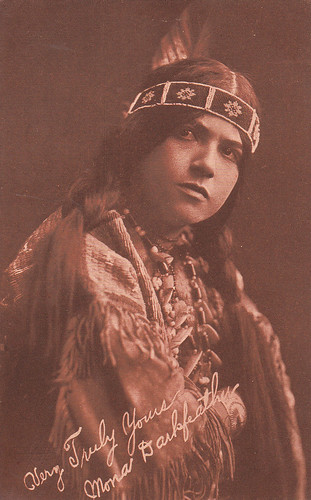
American postcard by Maurer, Schultz & Co., Los Angeles.
Mona Darkfeather was born Josephine Workman in Los Angeles on the 13th of January 1882. It seems that she began to perform on stage at the end of the 19th Century, as a Los Angeles Times 1897 stage review mentions a "Miss Josephine Workman rendering two whistling solos". This is indeed confirmed by the 1900 census, which lists her occupation as 'whistler'. In 1910, Josephine had her first leading role in the silent film A Cheyenne’s Love for a Sioux and soon became known as Princess Mona Darkkfeather. She had turned to the film industry after having seen an ad from the Bison Company asking for Spanish-type girls who would believably play Indians.
For several years, she specialised in Native American roles and starred for example in Owanee’s Great Love (1911), A Squaw’s Retribution (1911), An Indian Love Story (1911), The Massacre of Santa Fe Trail (1912), Star Eye’s Stratagem (1912), A Red Man’s Love (1912), An Apache Father’s Vengeance (1913), Apache Love (1913), An Indian Maid’s Strategy (1913), A Dream of the Wild (1914), Indian Blood (1914), The War Bonnet (1914), The Vanishing Tribe (1914), The Squaw’s Revenge (1914), The Fate of a Squaw (1914), The Vengeance of Winona (1914), A Message for Help (1915), The Circle of Death (1916), The Crimson Arrow (1917), The Hidden Danger (1917), …
Mona Darkfeather had an unusual role in the comedy The Indian Suffragettes (1914), in which she played Dishwater, who comes back to her tribe after having been acquainted with the suffragette movement during her stay at a Government school. She leads the other women to demand equal rights and the men are forced to do the housework and take care of the children. However, when the women go hunting and are attacked by a rival tribe, they have to call their husbands for help. After this debacle, the female community members come back to their usual duties.
She occasionally was given non-Indian parts such as in A Spanish Wooing (1911), The Hand of Fate (1912), Juanita (1913), Against Desperate Odds (1913), The Bottled Spider (1914), The Gypsy Gambler (1914) or None So Blind (1916). She also played Ada Payne, a reporter’s sweetheart, in a series of shorts based upon the character of explorer Henry Morton Stanley which were produced by the Centaur Film Company in 1915. In publicity, she was often touted as a real Native American. Nevertheless, in several interviews, she admitted that she was not and declared that she was of Hispanic descent. However, to give a certain legitimacy to her portrayals, she stated that she had received the title of Princess from an Indian chief and that she had a deep knowledge of Native American customs and languages. It’s questionable if this claim was an invention or if there was some truth in it. We’ll let you judge.
Her family tree was more complex than she alleged. Her paternal grandfather was born in England, her paternal grandmother was from Taos, New Mexico, and is believed to be of Native American Pueblo descent, her maternal grandfather was from Maryland and her maternal grandmother came from Chile. By the mid-1910s, the popularity of the type of Westerns she was associated with was in decline and her screen career ended in 1917, although she probably appeared later in an uncredited bit part in Rocking Moon (1926). At the end of her life, she had lost ties to her family and died destitute in 1977 as a ward of the State of California. For many years, her grave remained anonymous until her great-nephew had a marker installed in 2014.
Red Wing: The first Native American film star
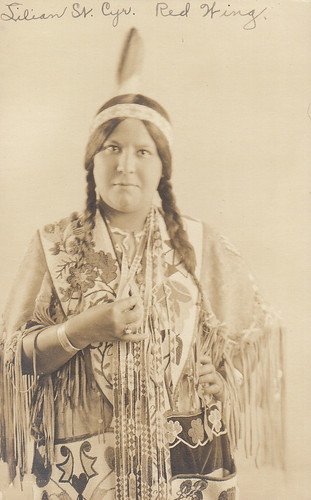
American Artura postcard.
Red Wing was born Lilian St. Cyr on the 13th of February 1884 in Thurston County, on the Native American Winnebago Reservation. She had French Canadians among her ancestors, hence her family name. Orphaned at an early age, she spent several years in boarding schools and graduated from the Carlisle Indian Industrial School in 1902. In 1905, she married James Young Johnson. As Wild West Shows were all the craze at the time, the couple decided to go into show business. They joined the cast of 'Pioneer Days: A Spectacle Drama of Western Life', a Wild West extravaganza which opened in November 1906 at the Hippodrome Theater in New York. After it closed in mid-1907, they soon teamed with Luther Standing Bear a.k.a. Chief Charging Hawk and took their show on the road. Lilian St. Cyr and James Young Johnson thus became Red Wing and Young Deer, names that were better suited to their stage performances. The trio broke up at the end of the summer of 1908.
To fit his new persona, James claimed that he was a full-blooded Native American, although he was of decidedly multi-racial ancestry. His maternal grandmother, who was termed mulatto, was born a slave and was emancipated in 1844. His maternal grandfather was most probably a white planter. Young Deer’s father, George Durham Johnson, who came from a relatively elite mulatto family, was a member of the Colored Soldiers and Sailors League and strongly supported civil rights for coloured people. George and his wife were buried in the Washington Harmony Cemetary, established in 1829 for blacks. Red Wing’s husband nevertheless had a link, through his paternal great-uncle, to the small mixed-race community of Nanticoke Indians of Delaware who, throughout their history, have mingled with White and Afro-Americans. In 1881, they were recognised as an Incorporated Body and were chartered as an official Native American tribe by the state of Delaware in 1922. With such a complex family history, no wonder Young Deer choose to reinvent himself as a Native American, as he knew that revealing his Afro-American roots would have a negative impact on his career.
As the 20th Century’s first decade was coming to an end, Red Wing and Young Deer turned to films. Westerns were then in vogue and people who could play Native Americans were in demand. They got leading roles in The Falling Arrow (1909) at Lubin and they were hired afterwards by the Bison company. For them, Red Wing was featured in, for example, A True Indian’s Heart (1909), Half-Breed’s Treachery (1909), The Red Girl’s Romance (1910), Perils of the Plains (1910), … Her growing popularity led Bison to churn out a special series of 'Red Wing movies', such as Red Wing’s Gratitude (1909), Red Wing’s Loyalty (1910), Red Wing’s Constancy (1910), For the Love of Red Wing (1910), Red Wing and the White Girl (1910) and The Flight of Red Wing (1910).
After their stay at Bison, the couple signed with Pathé and Young Deer soon became the manager of their West Coast studios in Ellendale. For Pathé, Red Wing starred in movies such as The Red Girl and the Child (1910), The Yaqui Girl (1910), Silver Leaf’s Heart (1911), The Cheyenne’s Bride (1911), Romance of the Desert (1911), Swiftwind’s Heroism (1912), For the Papoose (1912), A Redskin’s Appeal (1912), The Squawman’s Sweetheart (1912), The Wooing of White Fawn (1912), The Winning of White Dove (1912), General Scott’s Protégé (1913), A Redskin’s Mercy (1913), The Faithless Friend (1913), … Although she had to comply with some Native American stereotypes, she always sought to bring the most authenticity she could to her portrayals. After Pathé had decided to stop producing in the U.S.A. and to turn to distributing, Red Wing got her most famous role in Cecil B. DeMille’s The Squaw Man (1914) at the Lasky Company. Her performance as the self-sacrificing Nat-U-Rich got her very good reviews. She then was featured in the Selig movie In the Days of the Thundering Herd (1914), opposite Tom Mix.
In the mid-1910s, the vogue of Indian-themed Westerns was waning. Furthermore, Red Wing had put on weight and was beginning to look matronly. Her film career quickly declined. After her role as the heroine’s mother in Ramona (1916), she disappeared from the screen. From 1920 to 1923, she toured with her own vaudeville act: she gave demonstrations of tribal songs and dances, lectured on her film days and talked about Indian life and customs. In 1925, she made her last movie appearance in an uncredited bit part as a South Sea Island woman in Soul Fire (1925). From the mid-1920s, she supported herself by making Indian costumes and regalia. Her skills in bead, leather and feather work were greatly appreciated and her clients included, for example, members of Indian tribes, theatrical producers and performers or diverse associations, such as the fraternal Red Men’s Order which, despite its name, only comprised white men. Still promoting Indian culture, she again made occasional live appearances over the years at schools, at powwows, at department stores or at events hosted by various organisations. She also steadily participated in political activism to give recognition to American Indians. Her eightieth birthday was celebrated with a party in Manhattan, sponsored by the Indian League of America. The first Native American film star, who always stayed proud of her heritage, passed away on the 13th of March 1974.
Minnie Provost a.k.a. Minnie Devereaux: A heavyweight character actress
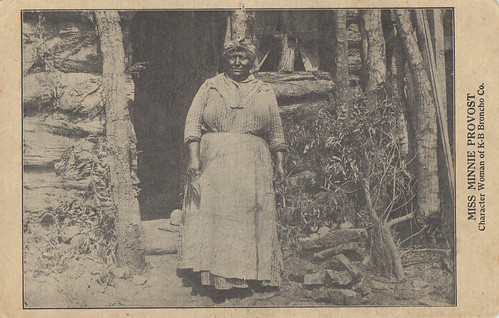
American promotional postcard for the Los Angeles Garrick Movie Theatre in Los Angeles. Photo: K.B. Broncho Co.
Minnie Provost a.k.a. Minnie Devereaux was born Minerva Burgess in 1869 in Oklahoma and was a member of the Native American Cheyenne and Arapaho tribes. In the 1910s and at the beginning of the 1920s, she was a popular character actress in movies and, with her large frame, didn’t go unnoticed.
One of her best-known films is probably Fatty and Minnie He-Haw (1914), a Mack Sennett comedy in which she plays an Indian who finds a dying Fatty in the desert, rescues him and takes him back to her village, where she decides to take him as her husband. Complications of course ensue and the two heavyweight comedians are involved in several funny plot twists.
In another Mack Sennett production, the successful Mabel Normand vehicle Mickey (1918), she is especially good as Minnie, the pipe-smoking Indian housekeeper of the orphaned heroine’s legal guardian, who has acted as a kind of surrogate mother to her. She was later seen in another Mabel Normand feature film, Suzanna (1922).
Minnie Provost also played Natoosh, Madlaine Traverse’s Indian servant, in Rose of the West (1919) and a funny photo of Charlie Chaplin sharing a laugh with Minnie was taken when he visited the set.
On several occasions, she played Afro-American characters, such as in Old Mammy’s Secret Code (1913), in which she portrayed a Confederate family’s old servant, who is shot as a spy by the Union army. In The Coward (1915), she was again given the role of the devoted mammy of a Confederate Southern family. In addition to her credited parts, that gifted performer is believed to have been an extra in more films. She passed away on the 5th of June 1923.
Elizabeth Threatt: The Indian princess of only one movie
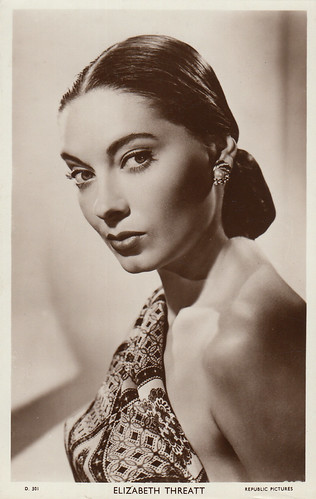
British postcard in the Picturegoer series, London, no. D 301. Elizabeth Threatt in The Big Sky (Howard Hawks, 1952). Comment Marlene: "I’m a bit puzzled by the reference to Republic Pictures on the postcard. Elizabeth Threatt’s only movie was distributed by R.K.O. and I haven’t found any mention of her being under contract to Republic. Maybe it’s a mistake." We do agree that this must be a mistake.
Elizabeth Threatt was born on the 14th of April 1926 in Kershaw, South Carolina, and was half-Cherokee. In the second half of the 1940s, she became a sought-after model and her beauty graced the pages of magazines such as Vogue or Harper’s Bazaar. At the beginning of the 1950s, she met director Howard Hawks, with whom she allegedly had a short-lived affair. He gave her the leading female role of Native American princess Teal Eye in The Big Sky (1952). It was her only movie and she went back to modelling. She retired after her third marriage in 1956. After her divorce in 1963, she settled in Concord, North Carolina, and led a very discreet life. That’s where she passed away in a nursing home on the 22nd of November 1992.
More actresses playing Native Americans onscreen
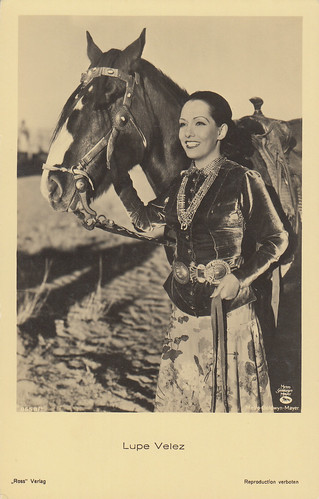
German postcard by Ross Verlag, no. 8658/1, 1933-1934. Photo: Metro-Goldwyn-Mayer. Lupe Velez, as Native American character Naturich, in The Squaw Man (Cecil B. DeMille, 1931).
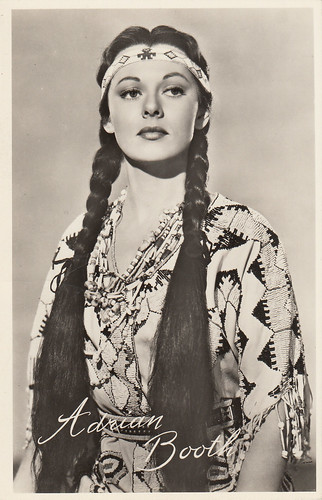
Dutch postcard by Takken, Utrecht, no. AX 1722. Adrian Booth as Native American character Aleeta in Rock Island Trail (Joseph Kane, 1950).

Spanish postcard no. 2737. Cyd Charisse as Native American character Adjidaumo and Stewart Granger in The Wild North (Andrew Marton, 1952).
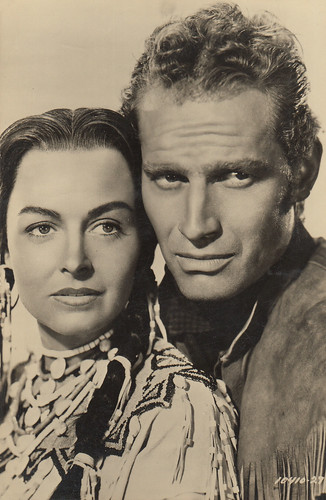
Spanish postcard by Archivo Bermejo, no. 7174. Donna Reed as Native American character Sacajawea and Charlton Heston in The Far Horizons (Rudolph Maté, 1955).
Text and postcards: Marlene Pilaete.
No comments:
Post a Comment